
VOICE Home Page: http://www.os2voice.org
[Newsletter Index]
[Previous Page] [Next Page]
[Feature Index]

VOICE Home Page: http://www.os2voice.org |
July 2002
[Newsletter Index]
|
| By Darrell Spice, Jr. © July 2002 |
While at Warpstock in Toronto last year, I attended a device driver presentation by Oliver Stein of IBM Germany. Amongst all the useful information he presented was a tidbit of special interest to me. I had recently installed a Linksys BEFW11S4(a cable modem router that included 802.11b wireless support) and I really liked the freedom the wireless access gave me when I booted my Thinkpad T22 under Win98 or Linux. Mr. Stein mentioned that ARtem(in English) had a wireless NIC, the ComCard, which had OS/2 support. The ComCard is based on the Lucent Orinoco chipset, which is used in many 802.11b wireless network cards; however, the drivers only work with ARtem's version of the NIC ( As well as the Bintec XAir PC-Card, an OEM'd version of the Artem card). He also mentioned that the ComCard was not sold in the USA and that ARtem did not sell directly to individuals.
 In hopes of finding a company that could ship me a ComCard,
I sent ARtem an email. They replied back that they would sell directly to individuals
in the USA via their export office. When I ordered the PCMCIA ComCard in October
it went for 349 DM. Shipping via DHL was an addition 70 DM. With the exchange rate
at the time, my total came to $171 USD. I was very impressed with the speed in which
my ComCard arrived, I placed my order on Tuesday the 23rd and it arrived Friday
the 26th. Artem also makes an ISA and PCI version of the ComCard, but only the PCMCIA
and ISA versions are listed as supported under OS/2.
In hopes of finding a company that could ship me a ComCard,
I sent ARtem an email. They replied back that they would sell directly to individuals
in the USA via their export office. When I ordered the PCMCIA ComCard in October
it went for 349 DM. Shipping via DHL was an addition 70 DM. With the exchange rate
at the time, my total came to $171 USD. I was very impressed with the speed in which
my ComCard arrived, I placed my order on Tuesday the 23rd and it arrived Friday
the 26th. Artem also makes an ISA and PCI version of the ComCard, but only the PCMCIA
and ISA versions are listed as supported under OS/2.
802.11b wireless cards have a built in 2.4 GHz radio unit, which supports up to 11Mbps data transmission at up to 160 meters outdoors, though only up to 30 meters indoors, and that depends on obstructions that may block radio waves.
In order for the ComCard to work, you must have functioning PCMCIA drivers. If you don't have functioning drivers, I recommending checking out Dr. Martinus' The Notebook/2 Site for help. If you cannot find what you need, consider subscribing to his discussion list.
The OS/2 drivers are included on the CD that comes with the ComCard. The driver files ARLTNDIS.NIF and ARLTNDIS.OS2 were located in \Treiber ComCard\comcard_os2\ along with README.TXT and COMCARD_OS2.EXE.
Following the instructions in the very brief readme file, I copied the files ARLTNDIS.NIF and ARLTNDIS.OS2 to x:\IBMCOM\MACS\ (replace x: with your OS/2 system drive letter) and then installed the NIC in MPTS.
To install the NIC, open up the System Setup folder and run the program Network Adapters and Protocols Services, as seen in figure 1.
figure 1, System Setup
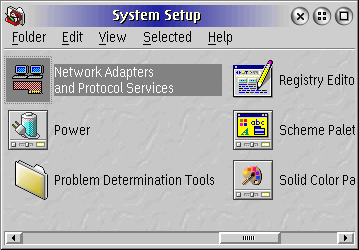
Once the program starts, click the Configure MPTS button.
figure 2, MPTS program

On the next dialog box make sure LAN Adapters and protocols radio button is selected, then click Configure
figure 3, Configure dialog
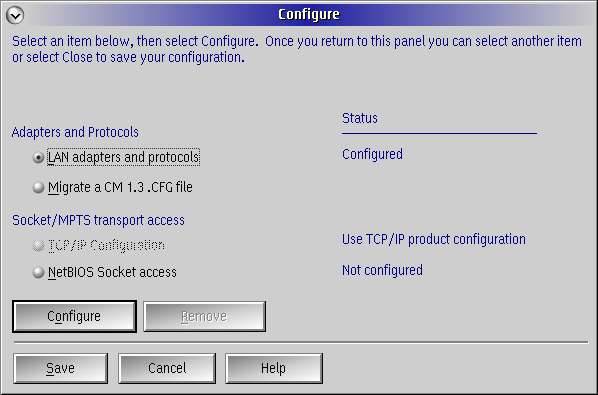
My system is running eComStation, which has an
figure 4, Adapter and Protocol Configuration dialog After changing the NIC, select Edit to change the parameters for your
system.
figure 5, Driver changed to ARtem ComCard As you can see in figure 6, quite a bit of German remains in the configuration
dialog. I thought this might prove to be a problem in figuring out how to configure
the card, but it was just a minor issue. Initially I only changed the SSID to that
of my home network, but after rebooting my system locked up. Removing the NIC prevented
the lockup from occurring.
figure 6, ComCard Parameters, initial values In some of the documentation I found on Dr. Martinus' site, it mentioned that
for most cards the IRQ and I/O will be handled via plug-and-play, but they must
often be manually set for network cards. I ran figure 7, ComCard Parameters, changed values (Original German version). After getting everything to run, I thought I'd try the special SSID of ANY that
is supposed to let your wireless NIC talk to any base station it finds. However,
this did not work. The driver included with my NIC was version 1.0 so I checked
ARtem's site and found a more current release, version 1.42. After installing the
new driver the SSID of ANY worked fine.
The ComCard works well under OS/2 once getting everything configured correctly.
One thing I missed from under Windows was a signal strength meter. I wondering if
the executable in the CD's driver directory might be one, so I attempted to run
it. It caused my system to trap. I eventually figured out it was in a Windows 32
bit format and suspect the trap was due to Odin(the
Win32 execution environment for OS/2) being installed on my system. By running it
under Windows I discovered it was a self-extracting archive that contained the same
3 files already in the driver directory.
Besides OS/2 and Windows, I also have Linux installed on my laptop. Originally
I was running Red Hat 7.3, but Red Hat did not support the ComCard. I switched over
to SuSE 7.3 Professional(wireless support is not included in the personal edition)
and was able to use the ComCard under Linux. As an added bonus, SuSE still included
the ability to access my HPFS partitions, something Red Hat no longer does.
ARtem (German site): http://www.artem.de/ Darrell has ported various video game console emulators to OS/2 http://home.houston.rr.com/spiceware/
[Feature Index]
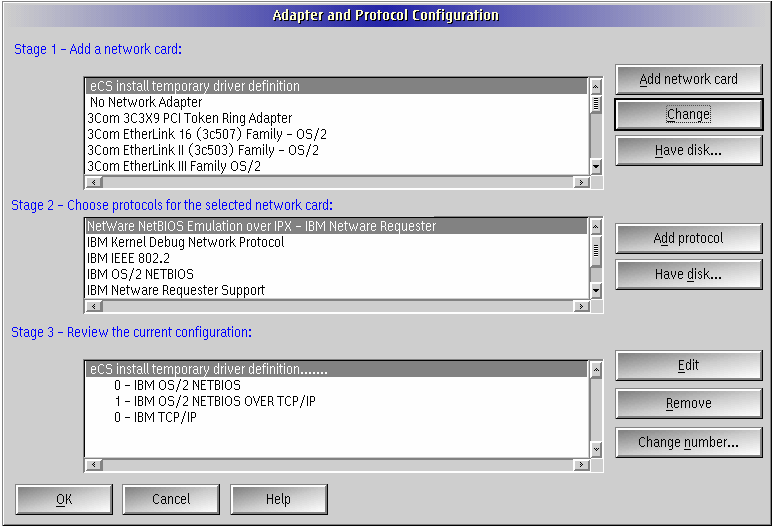
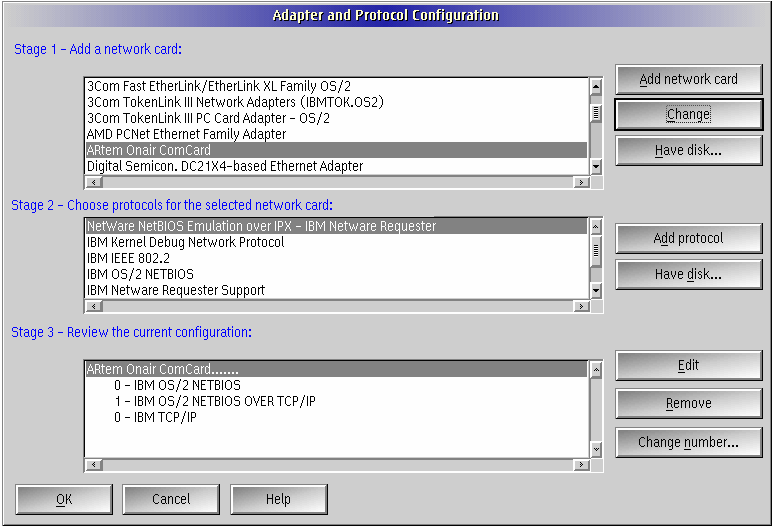
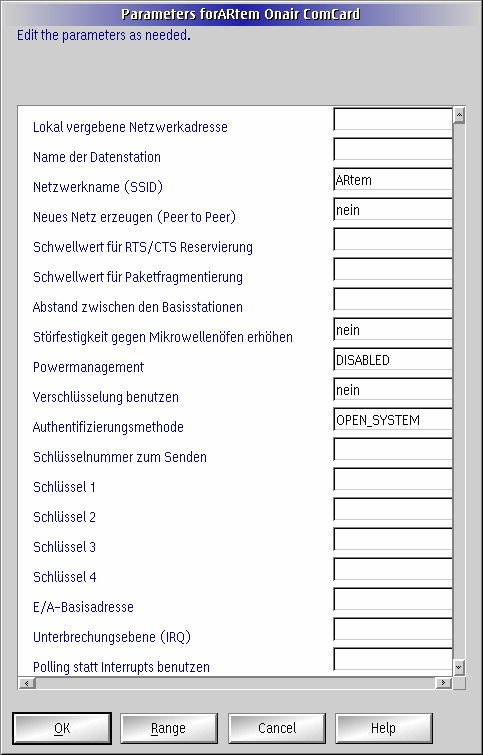
RMVIEW /IRQ
and found that IRQ 9 was free, so I changed the ComCard's IRQ parameter to 9. The
system no longer locked up with the ComCard installed, however it did complain about
the base I/O address. Everything worked fine once I changed the ComCard's I/O address(E/A-basisadresse
in the parameters dialog) to 180.
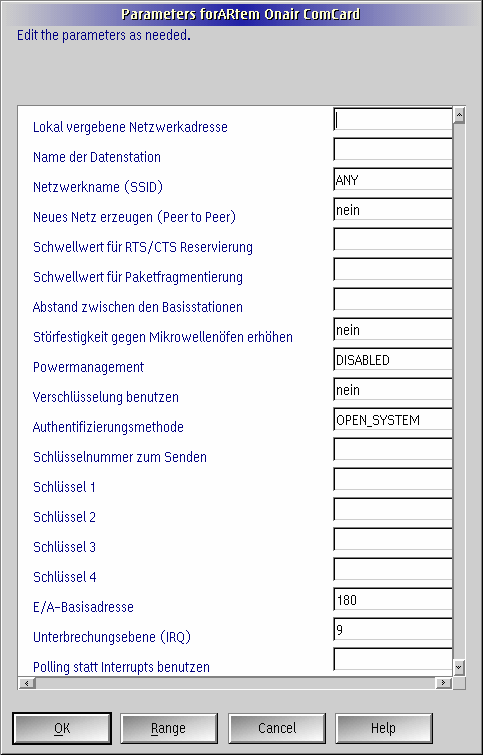
Figure 8, ComCard Parameters, changed values (English translation by Thomas Klein.
This arltndis.nif file
is available on the Warp Doctor site in the file download area. Hold down [shift]
when you right click on the link for it to be downloaded instead of displayed).
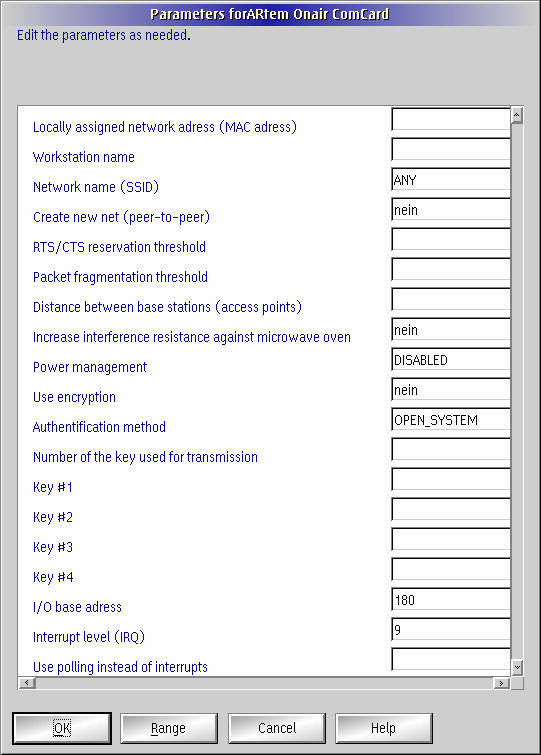
References:
ARtem (English site): http://www.artem.de/english/
ARtem Driver Page: http://www.artem.de/english/support/downloads.shtml
English version of arltndis.nif: http://www.warpdoctor.org/files/arltndis.nif
Bintec: http://www.bintec.de
Linksys: http://www.linksys.com/
Dr. Martinus' Notebook/2 Site: http://www.os2world.com/DrMartinus/notebook.htm
old site(some links are broken on the new site): http://www.os2ss.com/users/DrMartinus/Notebook.htm
Odin: http://odin.netlabs.org/
SuSE (German site): http://www.suse.de/
SuSE (English site): http://www.suse.com/
editor@os2voice.org
[Previous Page] [Newsletter Index] [Next Page]
VOICE Home Page: http://www.os2voice.org